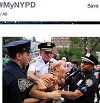
In April 2014. a hashtag campaign started by the New York City Police Department backfired after being inundated with photos of police brutality submitted via Twitter. This case study looks at why the campaign failed, and what brands can do to avoid similar Twitter catastrophes.
Cops Got Everyone to Tweet Photos of Police Brutality Thanks to Their Failed #myNYPD Hashtag http://t.co/5b0rlKO5ZO pic.twitter.com/fZxlh5N79l
— VICE (@VICE) April 23, 2014The NYPD sent a tweet on Tuesday 22nd April 2014, saying it might feature the photographs on its Facebook page.
The responses soon turned ugly when Occupy Wall Street tweeted a photograph of cops battling protesters with the caption "changing hearts and minds one baton at a time."
Other photos included an elderly man bloodied after being arrested for jaywalking.
Beating an 84 yr old man for jaywalking. #MyNYPD // keepin it classy! pic.twitter.com/oKndXEhZ9T
— Occupy Wall Street (@OccupyWallStNYC) April 22, 2014By midnight on Tuesday, more than 70,000 people had tweeted about police brutality, ridiculing the NYPD for a social media disaster and recalling the names of people shot dead by police.
Police officials declined to respond to questions about the comments, which were being posted at a rate of 10,000 an hour, or say who was behind the Twitter idea.
Best part of #myNYPD = pics of dogs being frisked pic.twitter.com/vHfmQHIHds
— Elif Batuman (@BananaKarenina) April 23, 2014There were many instances where respondents did send in the type of police-friendly photographs officials were hoping to get. The NYPD tried to make the best of a botched job by retweeting all the favourable photos, and the camapign wasn't a complete failure, as the stats show.
According to data from Brandwatch, after three days there were 43,000 mentions of the #myNYPD hashtag — and looking at the overall sentiment of these tweets, only 15% of these mentions were negative, 5% were positive and the rest were classified as neutral.
“The NYPD is creating new ways to communicate effectively with the community,” NYPD Deputy Chief Kim Royster said in a statement to USA Today. “Twitter provides an open forum for an uncensored exchange and this is an open dialogue good for our city,”
While the social data reveals that online sentiment is not overwhelmingly negative, the resulting media coverage became a PR headache for the NYPD- showing that it only takes a relatively small number of effective negative Tweets to turn a campaign bad.
Back in 2013, Wall Street giant JP Morgan ran a similar campaign, and was at the centre of a social media storm when it invited Twitter users to send questions to an executive using the hashtag #AskJPM. The bank was deluged with vitriol. More than 8,000 responses were sent within a six-hour period, two-thirds of which were negative.